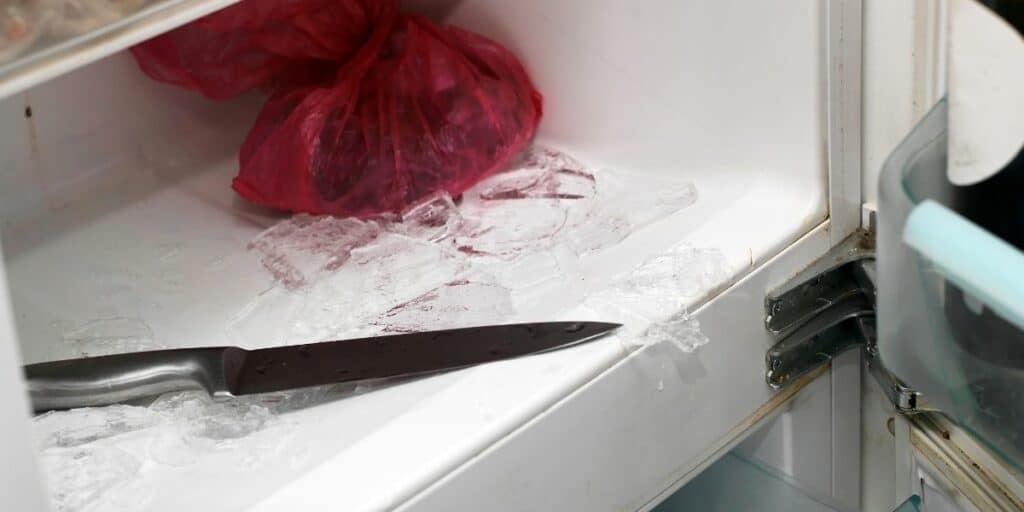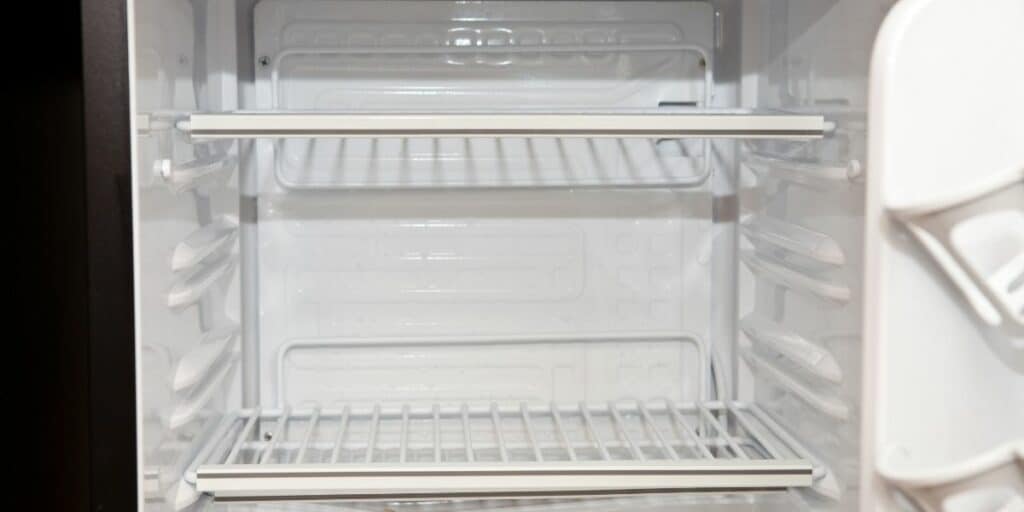
Defrosting a fridge can take anywhere between 2 to 4 hours depending upon the extent of the frost buildup and the external weather conditions. If the frosting is heavy and you wanna let it melt down naturally then it can take a long time. But if you use some of the DIY defrosting hacks, you can easily speed up the overall process.
If time is not an issue, then:
In case you don’t have 4 hours and wanna speed up the defrosting process we have some easy to execute hacks for you which will help you to get done with the whole process quite fast!
So, let’s right get into it…
(Before exploring any of the hacks below, make sure you have the fridge's power turned off and have removed food items from the fridge).

Blowing dry air is an easy way to introduce loads of continuous warm air into the fridge.
Ice will melt significantly faster when there is greater availability of heat energy in the surroundings. Introducing warmer air at a rapid pace will help in increasing the temperature of the ice by many folds.
Set a hair blow dryer to its highest level of the hot air setting and keep on blowing the ice. Target one particular zone at a time.
This process will rapidly speed up the overall defrosting process. You will see chunks of ice loosening up very shortly, but it can take anywhere from 40 minutes to over an hour for the defrosting process to complete properly.
The best thing is in most cases, you won’t be needing to blow all the frosted areas of the fridge. The heat generated while blowing a particular area will in turn end up melting the ice of the other areas of the fridge.
Take care so that the chord of the blow dryer doesn’t get wet.
In case you don’t have a hair blow dryer, you can also use the vacuum cleaner to blow the hot air onto the frosted surface.
This is probably the simplest yet the most effective way to deal with defrosting.
Just take a bowl of steaming hot water, put it on a tray (to avoid damaging the rack surface), and place it at the bottom rack of the fridge. Now gently close the fridge and leave it undisturbed for 30 minutes to 1 hour.
The doors of the fridge are very well sealed and hence the excess steam will help in speeding up the process of melting the ice. This will be enough under normal circumstances but if the frost condition inside the fridge is a wreck, then try placing multiple bowls of boiling water on each of the fridge racks (with a tray or towel beneath).
A spatula is essential if you wanna quickly remove the loosened-up ice from the fridge. So, using the spatula will allow you to give them that extra bit of force they need to break off from the surface. Make sure you take that extra bit of care to not damage the refrigerator surface by any means.
Always remember the goal is to break off the already loosened up ice and not the ice which is yet to be loosened up. So never apply a tremendous amount of force during the process as that can end up damaging the fridge surface or gas lines.
In case you don’t have a rubber spatula go for a wooden one but never use metallic ones as those can damage the fridge.
Dip a soft cloth into a bowl of warm water and keep rubbing it onto the walls and edges of the fridge. This will also help in loosening up that stubborn bit of frost present at the corners of the fridge.
Applying a bit of alcohol onto the cloth will also help in escalating the defrosting process further.
A fridge full of frost will end up defrosting much faster in a room that is warmer and airy. Open up the windows and doors and if possible, turn on the heating.
The goal is to keep the fridge door open and let the warm airflow into the fridge which further will boost the ice melting process. You can optionally even use a fan right in front of the open fridge door to enhance the entry of warm air into the fridge at a rapid pace.

The inside of a fridge is a very delicate place, so you risk damaging the refrigerator when you use a sharp object to remove the ice.
It may seem convenient at the moment because the sharp object may help you better remove the ice; but it’s like a double-edged sword, you also can end up hurting not only the fridge but yourself as well.
If the skin of the fridge gets scratched or damaged even to a little extent, it can end up affecting the cooling activity of the whole fridge. So, it’s always best to use a wooden, plastic or rubber spatula to scrape and remove the ice than metal ones.
Keeping the freeze on is pointless as it will be a waste of electricity and will only hamper the defrosting process. Firstly, the heat accumulation will help in the better melting of the ice. Secondly, there will be a huge watery mess inside, post the defrosting process so it’s always best to do this sort of work with the electricity power cut off.
This is quite self-explanatory as by not removing the edible objects before the defrosting process, you run the risk of compromising their quality. The power will remain off for a few hours and there will be a watery mess inside. So, it’s logical to remove the food items and place them in a small mini fridge. You can simply keep them wrapped in a newspaper or sealed in air-tight containers or insulated bags in the absence of another fridge.
When the ice starts melting, the water is bound to flow out of the fridge. Even if you try picking up the ice chunks off the fridge into a pan or tray, a watery mess is bound to occur. So, to keep the mess under control, it's best to lay down some old newspapers in front of the fridge.
This is the best time to sanitize your fridge as it’s just cleaned up and it’s empty. Even if it was just ice, psychrophilic bacterial contaminations are pretty common in refrigerators.
Prepare a mixture of vinegar, water, and detergent to rinse and wipe down the fridge thoroughly.
This is because the more you keep the door open, the more air from the outside will enter the fridge and frost up your fridge quickly.
If air from the outside keeps on entering the inside, it will lead to frosting nightmares regularly.
It can take roughly 3 to 4 hours for the defrosting process to occur if you just let it sit on its own with the power turned off. If the external weather conditions are warm, then defrosting can occur a bit quickly.
Use our hacks above to speed up the process.